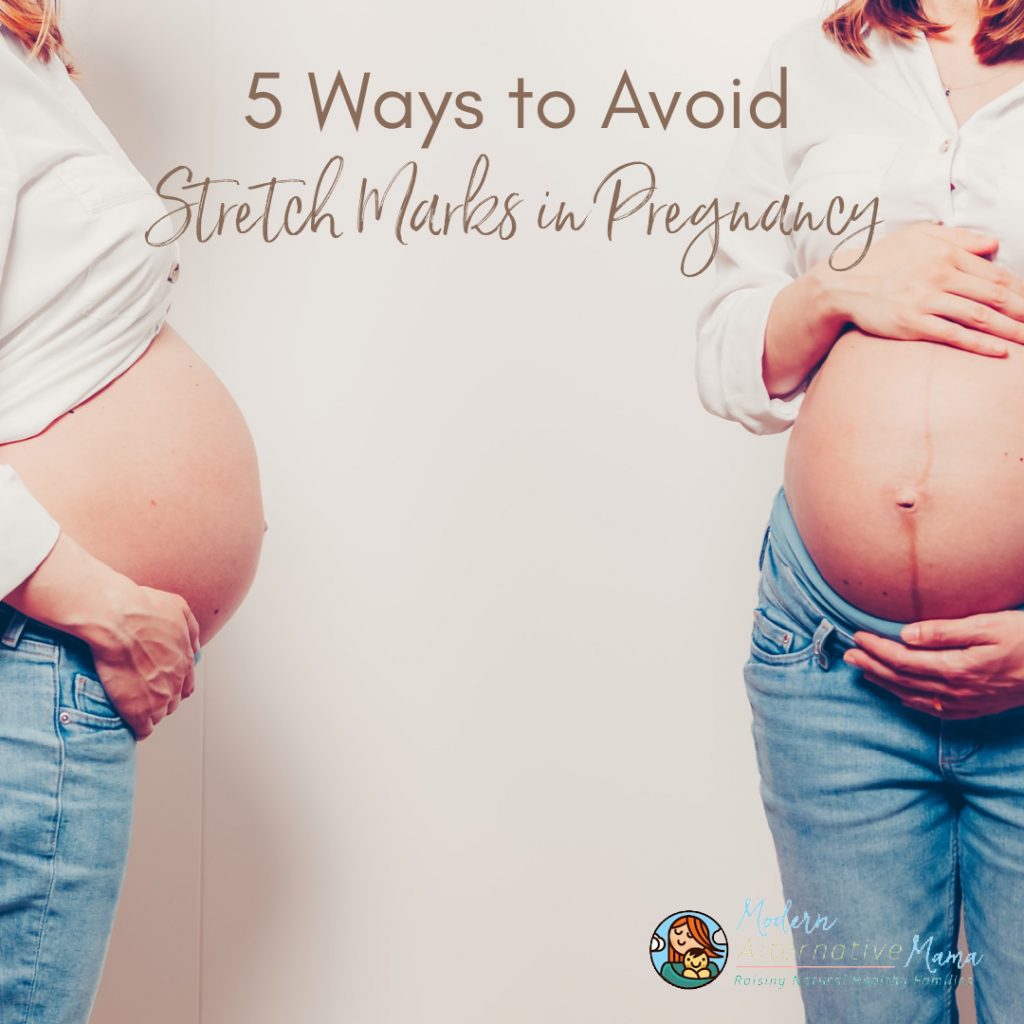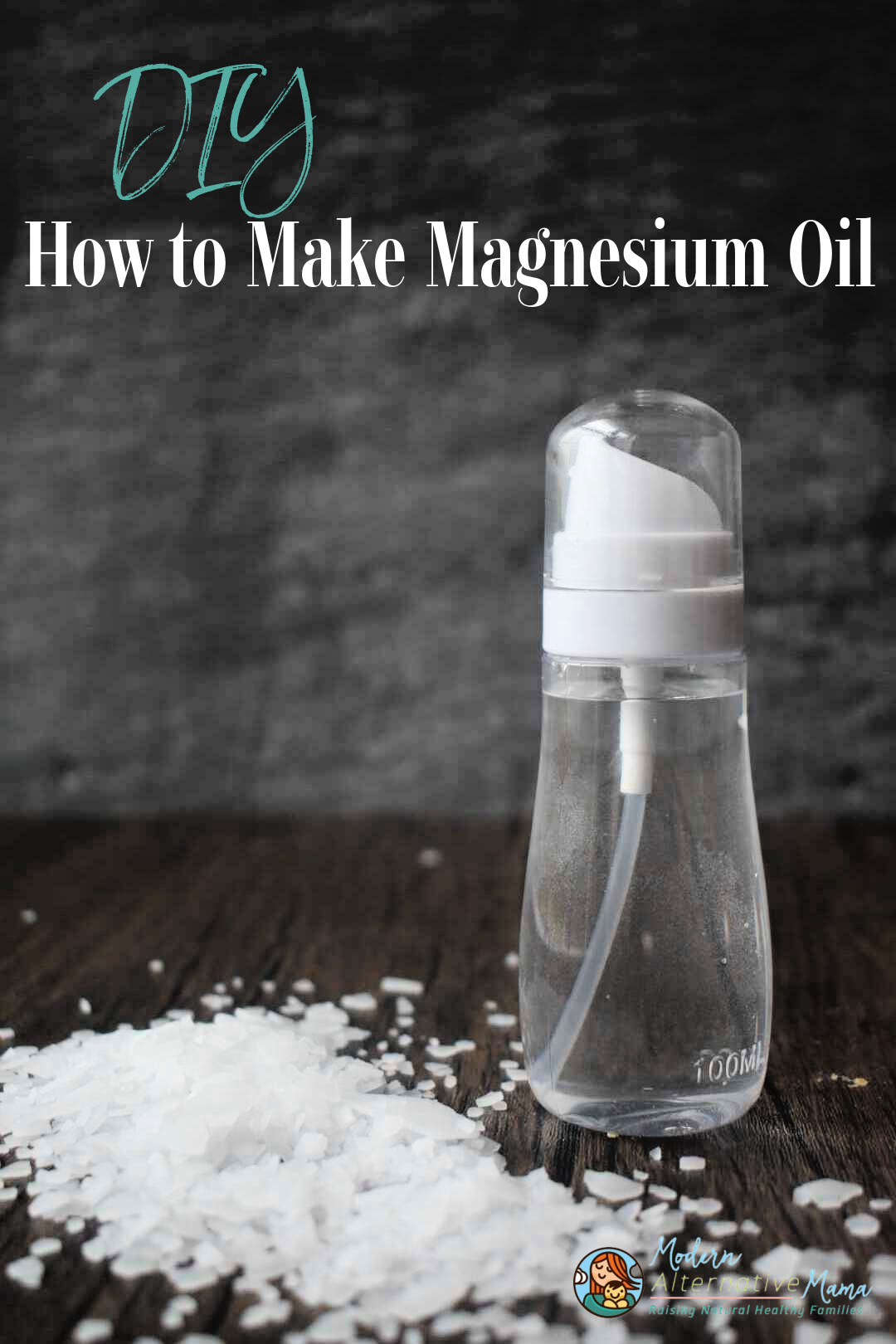Between the two authors of this post, we’ve birthed ten babies. Each of those birth journeys is unique with their own challenges and triumphs. A common issue we can both say we wanted to avoid during each pregnancy? Stretch marks!
A lot of women believe that stretch marks are just par for the course in pregnancy.
For quite awhile, the common thinking has been that stretch marks are genetic. That you’re vulnerable to them, or you’re not, and there’s nothing you can do about it either way. But there’s recent evidence showing this is not, in fact, the case. While genetics may play a factor in stretch mark development, they aren’t the only reason that they can develop (source). Also, genetics aren’t a guarantee that they will develop. (There are genetic conditions like Ehlers-Danlos and Marfan syndrome which do lead to increased likelihood of stretch marks, but these conditions are rare for most).
Since stretch marks bother many women (although truly– during pregnancy you’re making a new person — you’re beautiful whether you have them or not), it’s obviously a very interesting subject. And pregnancy isn’t the only time of life when stretch marks can occur, so we’ll look at a few scenarios then cover what might help prevent or reduce their appearance.
4 Situations When Stretch Marks are Most Likely to Occur
- Pregnancy: When women are pregnant, their bellies can grow very rapidly, especially in the last several weeks of pregnancy, making stretch marks in that area more likely (source). For some women, stretch marks may occur during breastfeeding.
- Rapid Weight Gain or Weight Loss: Sometimes weight can pack on very quickly…or be lost just as quickly – think during times of severe illness. Both scenarios can result in stretch marks (source).
- Periods of Rapid Growth during Adolescence: Teens can get stretch marks during rapid growth spurts. For teen girls these usually occur on the buttocks, thighs, and calves. Teen boys tend to be affected on the buttocks, lower back, and knees (source).
- Presence of Adrenal Disorders – High cortisol levels are associated with the development of stretch marks. Cortisol can weaken the elastin fibers in the skin. In more severe cases, Cushing’s disease, for example, can contribute to severe pink and purple stretch marks in both children and adults (source).
Going back to pregnancy specifically, stretch marks are NOT genetic and they certainly are not inevitable.
So what can be done to help prevent, or at least reduce the severity of, stretch marks?
5 Ways to Avoid Stretch Marks in Pregnancy
Up until just a few years ago, doctors and researchers maintained that there was “no evidence” that any topical cream or ingredient could reduce or eliminate stretch marks.
That doesn’t necessarily make sense, though. Stretch marks occur when the top layers of skin stretch faster than the connective layers underneath, leading to little red/purple marks or grooves in the skin. Over time, these fade to silver-ish or white and are not as noticeable.
The problem is the skin’s lack of elasticity. That it isn’t stretching fast enough. What we would need to do is help the skin stretch more easily. And yes, you can do that with certain topical ingredients and key nutrients.
Let’s get into 5 ways you can prevent or reduce the appearance of stretch marks.
1. Promote collagen production with nutrition
Collagen is a protein found in our skin, digestive system, muscles, tendons, and blood vessels. It works as a “glue” to hold these body components together. Production of collagen decreases as we age. Certain nutrients can help boost our collagen production! Nutrients and vitamins to consider eating more of include:
- Vitamin C (source): Vitamin C is important to promote collagen synthesis (and reduce oxidative stress). It’s found in citrus fruits and berries. Immune-Aid, for example, includes camu camu, acerola berry, and orange peel.
- Zinc/Copper (source): Zinc and copper work to activate collagen synthesis and maturation. These nutrients are found in meats, seafood, nuts, and even cocoa powder. Oyster-Min capsules and Cocoa Calm powder are simple real-food sources if you need to fill gaps in your diet.
- Glycine (source): Glycine is an amino acid that works as a building block for proteins, especially collagen. Another amino acid, methionine (present in meats) can deplete glycine. So eating glycine-rich foods like gelatin, spinach, seeds, seaweed, and poultry skin is helpful to maintain that balance. Bone broth is another great source of glycine. (Check out this chicken stock tutorial here).
- Vitamin D (source): Vitamin D stimulates collagen biosynthesis. The sun is the best source of vitamin D, but food sources include cod liver oil, beef liver, and fish. (Learn more about vitamin D here).
When it comes to adding nutrients into your diet, consider focusing on food and whole food nutritional supplements before standard isolate vitamins. You can learn more about mega-dosing supplements in this post.
You might also consider supplementing with collagen peptides. We like this supplement for collagen.
And if you’re wondering if there are other nutritional gaps that you might be missing, check out this interactive Nutritional Deficiencies Quiz.
2. Rest & Relax
As mentioned above, periods of high cortisol production — the stress hormone — are associated with lowered amounts of elastin in your body, which ages your body in general and leads to skin that isn’t as resilient. So, skin becomes more prone to stretch marks. This means long-term stress and anxiety can actually increase your risk of stretch marks.
On the positive side, research shows that collagen peptides can reduce the negative effects of high cortisol (source).
Ideas to lower cortisol:
- Diffuse your favorite essential oil blends or use a roller! Smelling lavender and rosemary can decrease cortisol level according to research (source). Check out this pregnancy and nursing-safe essential oils chart here.
- Invest in your long-term health by taking steps to regain your hormone balance. Download this comprehensive free guide to get started.
- Utilize herbs such as lavender, lemon balm, and holy basil which are known for their calming properties. Find them together in this calming blend.
3. Dry Brushing
Dry brushing is basically a gentle body massage for the skin! Dry brushing also helps the skin produce more collagen which can help reduce the appearance of stretch marks. It’s also beneficial for detoxification, exfoliation, and to support the nervous system.
It’s important to be gentle when dry brushing and there are proper techniques to follow. Learn how to dry brush in this free guide!
4. Aloe Vera
Do you grow aloe vera in your home garden?
Research shows aloe vera can reduce itchiness and the spread of stretch marks (source)! It’s no surprise that aloe vera gel has been found to help reduce the effects stretch marks can cause. Aloe is rich in skin-benefiting vitamins including A, C, and E.
If you grow aloe in your home garden, harvest that fresh gel for its amazing natural moisturizing properties! Or, look for a pure aloe vera gel without added colors and filler ingredients.
Learn more about aloe vera in this herbal profile.
5. Natural Oils & Butters for Massage
Combining oils that are known to help skin stretch and heal naturally really can affect whether or not you get stretch marks — or how bad they are. It’s true that certain women are more prone than others, but just because you are prone to stretch marks doesn’t mean there is nothing you can do. It means that you have to be more vigilant about what you do to prevent them or treat them.
The thing is, the common oils that many people claim really work, like olive or cocoa butter, aren’t among these oils. Instead, you need a high-quality product that contains the oils that truly do work. These oils need to focus both on collagen production and elastin production to help the skin.
A study that came out in 2013 used vitamin E, rosehip oil, and two other natural ingredients known to promote collagen enhancement in order to prevent stretch marks. They found significant differences in the number of women who got stretch marks, the severity of those stretch marks, and how quickly/badly any stretch marks progressed!
A closer look at key ingredients for stretch mark prevention and/or fading:
- Rosehip oil: Made from the “seeds” of roses, a moisturizer containing this oil reduced the severity of stretch mark development in pregnant women during a research study (source). Rosehip oil also promotes the production of keratinocytes which help to stimulate collagen production (source)!
- Comfrey: This herb contains allantoin, which aids in cell formation – so it’s beneficial to heal and fade both new and old scars (source). Research also demonstrates that topical use of comfrey speeds up skin regeneration (source).
- Grapeseed oil: This oil is beneficial for multiple issues, but specifically for stretch marks the power of grapeseed comes from its antioxidant effects which strengthen collagen to promote skin elasticity and flexibility. Grapeseed oil is rich in antioxidant and anti-inflammatory constituents: mainly tocopherol, linolenic acid, resveratrol, quercetin, procyanidins, carotenoids, and phytosterols (source). Research shows that the proanthocyanidins in grapeseed oil is 20 times greater than vitamin E and 50 times greater than vitamin C (source)!
Our favorite go-to moisturizer that includes these super skin-nourishing ingredients is Earthley’s Soothing Belly Butter. It’s crafted especially for growing bellies! This blend is also great for dry or eczema-prone skin. Handcrafted with organic mango butter, organic cocoa butter, organic comfrey leaves, organic grapeseed oil, and organic rosehip seed oil, this body butter has a luxurious feel and a natural chocolaty scent. Check out the reviews here!
Massaging nourishing oil on your belly, combined with a diet that’s high in collagen-boosting nutrients, may help to prevent stretch marks entirely!
Kate’s experience – The ones I had from my first pregnancy are just barely visible anymore, and I haven’t gotten more (except I think there are a couple on my hips, where I wasn’t putting any lotion or oil).
Steph’s experience – I truly believe that tons of bone broth and massaging with these nourishing butters/oils saved me from developing any stretch marks during my pregnancies. The stretch marks I have from my teen years also appear less noticeable.
Try these 5 ways to prevent stretch marks — they really do help!
Have you ever tried anything to prevent or treat stretch marks? Did it work?
**Steph Sinclair contributed to this post.**








I used wheat germ oil and a hight potency vitamin e oul and I dont have stretch marks! My mother is covered in them, so I agree with the study. You can prevent them.
I did dry brushing throughout my pregnancy and I swear it’s what kept me from getting stretch marks. I’ll definitely keep this oil blend in mind though for when I’m pregnant with kiddo 2 and doing the dry brushing of course.
I have a hard time with these sorts of claims. Maybe Im just bitter that I have LOTS of stretch marks 😉 But most people I hear talk about them, itjust seems like there’s no connections. My mom didnt have any during her 5 pregnancies, but she got them on her breasts when her milk came in. The commenter said her mom had some but she didn’t due to the product she used, implying that she would have been prone to them becasue of genetics. But my genetics should have made me not prone to them. My skin scars terribly from the tiniest thing. The diet claims irritate me too. i have many friends who eat SAD and all that. No stretch marks or loose skin for them. My diet did not help in this area. Again, maybe I’m just bitter and biased toward the evidence. 😉 It was nice to see a study cited, as other posts like this are usually like….I ate all theright foods and I didnt get stretch marks so you should do it too! When maybe they would not have gotten any regardless of their diet.
Yes,
I used NOW brand super concentrated vitamin E oil AND daily dry brushing. I also used one of those skin massage brushes when rubbing oil on through out the day. I was NOT gentle on my skin. I heard that its not the oils/lotions that work but the circulation created by rubbing it on. There were days when my skin was tender from the dry brushing but I’d still do it. It worked, 2 pregnancies, because I have tons of stretchmarks on my hips and boobs from puberty and also very sensitive skin. Over the years, out of all my pregnant friends (12) that I’ve told about this regimen, only one got them and she later admitted she only used the oil and only gently rubbed it on. Also, I gained 60 lbs per pregnancy sooooo….. I do believe you can prevent them
I used dermelastic serum during pregnancy to prevent stretch marks, and it worked! My mom had a lot of stretch marks, so I was paranoid. I rubbed dermelastic serum on diligently twice a day and made it through pregnancy without any stretch marks. It also has a nice smell, particularly compared to a couple other stretch mark creams I tried.
I was in my second month, and throughout the whole pregnancy I used the Somaluxe Stretch Mark Cream because its 100% chemical free. I used it twice a day, and three times per day during the last trimester. I continued to use it for one more month postpartum. I don’t have stretchmarks at all! It works perfectly. (I also drank a lot of water during my pregnancy (at least 10-12 glasses per day), I read it also helps you with stretchmarks and swolleness.